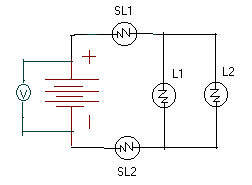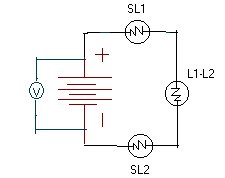BEE
COMBINATION CIRCUITS
This is the most common type of circuit that you will encounter, it is subject to OHM'S LAW just as ALL
circuits are.
E = IR I = E/R R = E/I
Inorder to solve for " I " we will first simplify the circuit.
Using the product over the sum method, L1 and L2 can be reduced to a single value resulting in a simple
series circuit or if more then two branches are involved the other equations for parallel resistance can be used.
If we use the same values of voltage and resistance that we used in the Series and the Parallel ckt.s
then we have 30volts and each lamp is 10 ohms. In a real circuit we could measure these parameters.
I = E/R
First to simplify we use:
Rt = R1*R2/ R1+R2
or in this case
Rt = L1*L2/L1+L2
Rt = 10ohms * 10 ohms/ 10 ohms + 10 ohms
Rt = 100/20
Rt = 5 ohms
The effective resistance of L1+L2 is 5 ohms
With this we can get Rt for the circuit by adding:
SL1 + SL2 + ((ER)L1,L2)
or
10+10+5
Rt = 25 ohms
Now we have enough information to solve for " I ":
I = E/R
I = 30 volts/ 25 ohms
I = 1.2 amps.
Knowing the current flow in the circuit we can calculate the voltage drop across each component.
E = IR
E(SL1) = 1.2amps.* 10ohms
E(SL1) = 12volts
Since SL1 and SL2 are the same value and the total current must flow through both then "E" is
the same for both or 12volts+12volts = 24volts
also
Since the total voltage drop in a circuit is equal to the applied voltage, then the "E" across
((ER)L1,L2) is 30(the applied voltage) - 24( the total voltage drop across SL1,SL2) = 6 volts.
To prove this:
E = IR
E = 1.2amps* 5 ohms
E = 6 volts
Now we have:
12 volts + 12volts+ 6volts = 30 volts (the applied voltage)
To break it down to each leg of the L1,L2 circuit requires that we know that the current ("I")
divides in a parallel circuit according to the resistance in that branch of the circuit. In this case
the resistance is equal and the current is divided equally.
I = E/R
I = 6volts/10 ohms
I = .6 amps.
If we add the current flow in each branch we again get the total flow in the circuit or:
0.6 amps. + 0.6 amps. = 1.2 amps.
If the resistance in each leg were different we would use the same procedure, but would be
required to do the math for each different value.
Hope This is of some help, GOD BLESS


